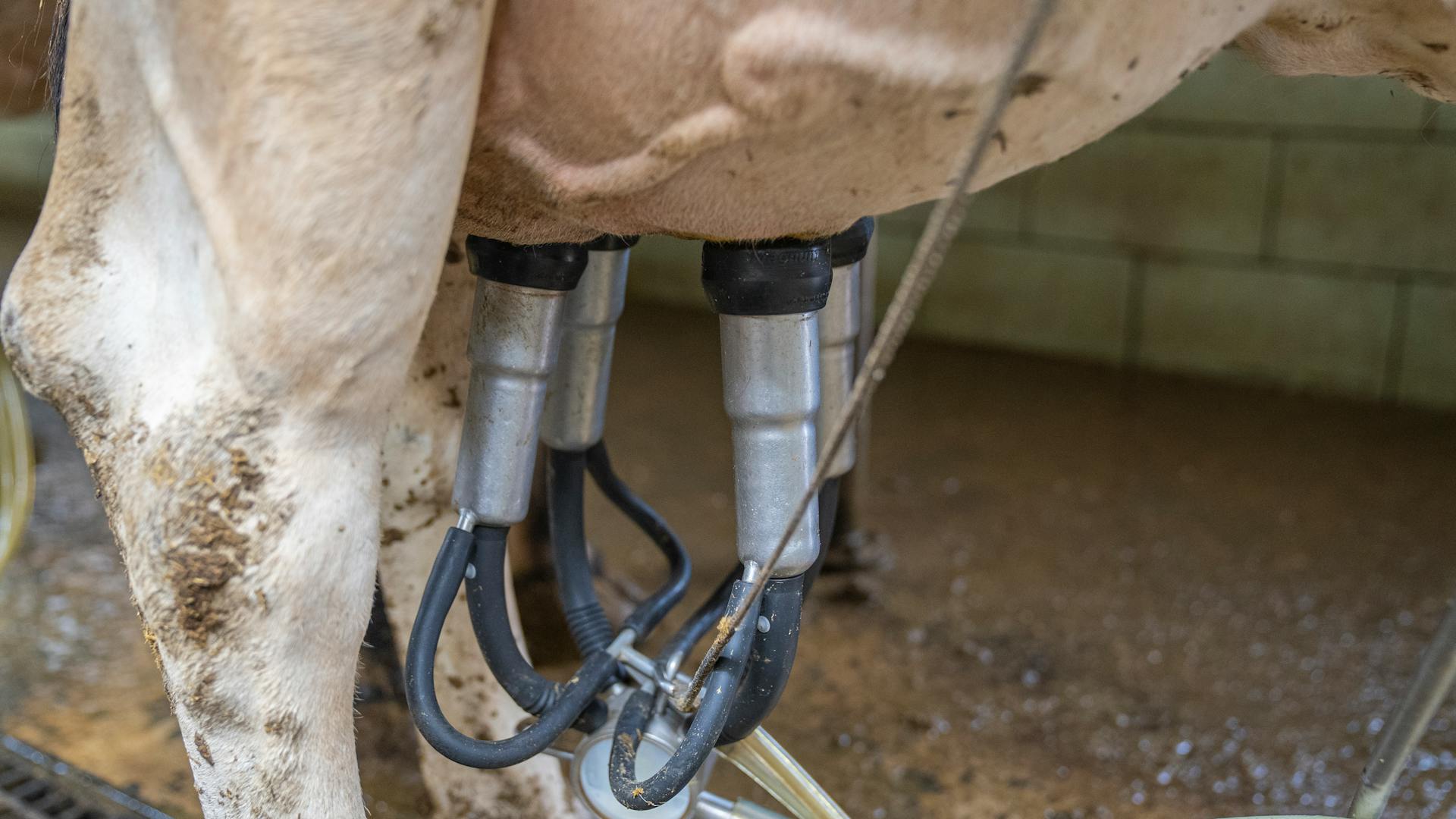
Swollen teats in female dogs can be a concerning issue for pet owners. Swelling is often caused by milk production after whelping, which can lead to discomfort and pain for the dog.
A swollen teat is usually accompanied by redness, warmth, and a foul odor. These symptoms can indicate mastitis, a painful infection of the breast tissue.
If left untreated, mastitis can lead to serious complications, such as abscesses and sepsis.
You might like: Female Dog with Swollen Nipple
What Is Mammary Inflammation?
Mammary inflammation, also known as mastitis, is a common issue in female dogs.
It occurs almost exclusively in nursing females, which is why you often see it in mothers with puppies.
Mastitis is most likely to happen during weaning, especially if weaning is forced or abrupt.
This is because the milk backs up and can be very painful for the mother if not regularly drained.
Engorged glands are more susceptible to infection, which can lead to mastitis.
A different take: Female Dog with Mastitis
Mastitis can be caused by a lack of milk flow or a bacterial infection.
If left untreated, a bacterial infection can enter the bloodstream and lead to sepsis, which can be fatal to the mother and her pups.
However, if caught early, the prognosis is good, especially if it's caused by a lack of milk flow.
For your interest: Female Dog Lactating but Not Pregnant
Causes and Risk Factors
Mastitis, the underlying cause of swollen teats in female dogs, is often a bacterial infection that enters the mammary gland through the teat canal. This can happen due to minor injuries or trauma to the nipple or mammary gland.
Bacteria like Staphylococcus, Streptococcus, and Escherichia coli species are commonly implicated in canine mastitis. These organisms are part of the normal skin flora but become problematic when they enter the sterile environment of the mammary gland.
Regular milk production requires regular demand from nursing, and if not regularly drained, the milk can back up and cause mastitis. This swelling alone can be the cause of mastitis because engorged gland(s) are more susceptible to infection.
You might enjoy: Female Dog Yeast Infection Treatment
The most common cause of mastitis is the entry of bacteria through the teat canal, often due to minor injuries or trauma to the nipple or mammary gland. This can happen during nursing when puppies have sharp teeth or nails, or as a result of poor sanitation practices.
Dogs that have had mastitis previously are at a higher risk of developing it again. In non-pregnant or non-lactating dogs, mastitis can arise as a secondary infection that spreads from another part of the body or as a symptom of mammary gland cancer.
Here are some common causes of mastitis in dogs:
- Bacterial or fungal infection of the teat or mammary area in pregnant dogs
- Loss of newborn puppies resulting in the accumulation of milk
- Milk clots or backed-up milk
- Unsanitary whelping box
- Damp birth site
Symptoms and Diagnosis
Symptoms of a female dog's swollen teats can vary depending on the severity and cause of the infection. You may notice a swollen nipple, or in more severe cases all of the mammary tissue can become swollen and inflamed.
Teats that are red or inflamed, hot to touch, or painful to touch are common symptoms of mastitis. Milk may appear discolored with blood or pus, and lumpy mammary tissue may be present.
For another approach, see: Female Dog Hernia
A veterinary surgeon will diagnose mastitis based on a clinical examination of your dog. Additional tests, such as blood tests to assess your dog's immune status and hydration status, may be performed to determine the cause of the infection.
Here are some common symptoms of mastitis in dogs:
- Teats that are red or inflamed
- Teats that are hot to touch
- Teats that are painful to touch
- Milk may appear discolored with blood (red) or pus (green/yellow)
- Lumpy mammary tissue
- Reluctance to nurse puppies or aggression toward puppies
- Restlessness
- Reduced appetite
- Fever
- Lethargy
Symptoms
Symptoms of mastitis in dogs can vary depending on the severity and cause of the infection. You may notice that your dog has a swollen nipple or mammary gland, which can be painful to touch.
Teats that are red or inflamed, hot to touch, or painful to touch are common symptoms of mastitis. Milk may appear discolored with blood (red) or pus (green/yellow). Lumpy mammary tissue can also be a sign of mastitis.
Some dogs with mastitis may be reluctant to nurse their puppies or become aggressive towards them. Restlessness, reduced appetite, fever, lethargy, and vomiting are also possible symptoms. In severe cases, gangrene mastitis can occur, causing the teat and surrounding tissue to appear black, bruised, and develop large open wounds.
Here are some common symptoms of mastitis in dogs:
- Pain and discomfort, particularly during nursing
- Discolored, thickened, or ulcerated skin over the glands
- Discharge from the nipples, which may be pus-filled, bloody, or unusually colored
- Reluctance to nurse puppies
- Lethargy
- Fever
- Decreased milk production
- Reduced appetite and weight loss
- Enlarged lymph nodes in the region of the mammary glands
In extreme cases, abscesses may form, or the infection can spread to the bloodstream, leading to a life-threatening condition called septicemia. If you suspect your pet is suffering from mastitis, you should contact your vet directly for an assessment.
How Is Diagnosed
Diagnosis begins with a physical examination of the affected area. This is where a veterinary surgeon or doctor will assess the symptoms and look for signs of infection.

A clinical examination may be necessary to diagnose mastitis in dogs. This involves a thorough examination of the dog's overall health.
Blood tests may be performed to assess the dog's immune status and hydration status. This can help identify any underlying health issues that may be contributing to the mastitis.
A sample of the pus or infected milk may be taken to isolate the bacteria involved. This will guide treatment options and help determine the best course of action.
In some cases, additional tests may be necessary to determine the cause of mastitis. These can include cytology or fine needle aspirate, ultrasound, radiograph, examination of milk or blood from the teat under a microscope, and blood work.
Some dogs may have chronic mastitis, which is long-term inflammation without symptoms. Mild cases are not usually life-threatening unless the condition advances.
A unique perspective: Dog Names Female Start with S
Will It Resolve on Its Own?
Mild cases of mastitis can sometimes resolve independently, but in those cases, your dog will not show signs of mastitis.
Mild infections can linger, leading to chronic, subclinical mastitis, which affects the puppies through poor milk quality.
Chronic, subclinical mastitis can potentially even lead to toxic milk syndrome in puppies.
A fresh viewpoint: Original Female Dog Names
Steps to Recovery
Recovering from a swollen teat in your female dog can be a challenging process, but with the right treatment and care, she can get back to her normal self.
Mild cases of mastitis can be treated at home with a warm compress applied every few hours to encourage drainage and relieve inflammation. The compress can be made from a clean cloth soaked in warm water, wrung out, and gently placed on the affected area for about 10-15 minutes.
In some cases, gentle massage of the teat and hand milking may also be recommended to break up congested tissue and clear the gland. However, it's essential to consult a vet before trying these remedies, especially if your dog is nursing puppies.
If your dog is experiencing mastitis in association with a false pregnancy, hormone treatment may be necessary to reduce the size of her mammary glands and dry up the milk.
Take a look at this: Treatment for Female Dog Incontinence
In severe cases, hospitalization may be necessary, and surgery may be required to remove the affected gland. Dogs that reach this level of infection have a guarded prognosis, and the mother may lose functional use of the gland.
Here's a summary of the typical steps to recovery:
- Warm compresses to encourage drainage and relieve inflammation
- Gentle massage of the teat
- Hand milking (if recommended by a vet)
- Antibiotics to combat bacterial infection
- Non-steroidal anti-inflammatory drugs (NSAIDs) to reduce inflammation and provide comfort
- Hospitalization and surgery (in severe cases)
Prevention and Care
Spaying your female dog can significantly reduce the risk of mastitis, as it eliminates the chance of having a litter and the associated risks. This is because mastitis is most prevalent in female dogs that have not been spayed.
Maintaining good hygiene is essential in preventing mastitis. Keep the whelping area clean and dry, and regularly change bedding to reduce the risk of bacterial infections. You can also use disposable material to line the whelping box and change it a few times daily.
Trimming and filing the puppies' nails can help reduce the risk of creating open wounds as a route for bacteria. This is especially important when the pups are feeding, as it can help prevent them from scratching their mother's skin and causing trauma.
Suggestion: Dog Behaviour after Spaying
To reduce the risk of congestion, ensure that all mammary glands are being used for nursing. You can hand-strip milk from engorged mammary glands to help with this.
Here are some key tips to prevent mastitis:
- Keep the environment and whelping box clean
- Carefully clip or file the edges of puppies’ nails
- Keep the mother’s skin clean around the mammary glands
- Ensure that all mammary glands are used for nursing
If you do notice any signs of discomfort or swelling in the mammary glands, contact your veterinarian immediately. Regular follow-up with the veterinarian is crucial to ensure complete recovery and prevent recurrence.
Types of Infections and Complications
Female dogs with swollen teats can experience a range of infections and complications, including septic mastitis, a severe and potentially life-threatening condition.
Septic mastitis can lead to abscess formation, systemic infection, or sepsis, making it extremely painful and requiring immediate veterinary intervention.
In advanced cases, the affected gland may rupture, discharging pus and causing further distress.
Can Get an Infection When Not Pregnant?
Dogs can get mastitis even when they're not pregnant, although it's less common.
Mastitis in non-pregnant dogs can be caused by a hormone imbalance, such as a phantom pregnancy.
Bitches that have aborted their litter may still produce milk and be at risk of mastitis.
In some cases, mammary enlargement in non-pregnant dogs may suggest a phantom pregnancy, which can lead to mastitis.
A unique perspective: Female Dog Pregnancy Stages
Types of Infections
Mastitis in dogs can be caused by various types of infections, and understanding these types is crucial for effective treatment.
There are several types of mastitis in dogs, based on the severity and nature of the inflammation. These include bacterial mastitis, which is the most common type and is caused by bacterial infections such as E. coli and Staphylococcus aureus.
Fungal mastitis is another type, which is caused by fungal infections such as Candida and Aspergillus.
In some cases, mastitis can be caused by viral infections, which can be life-threatening if left untreated.
Septic
Septic mastitis is a severe form of mastitis where the bacterial infection leads to abscess formation, systemic infection, or sepsis.

This type of infection is extremely painful and requires immediate veterinary intervention. If left untreated, it can lead to serious complications.
Symptoms of septic mastitis include a swollen and painful gland, and in advanced cases, the affected gland may rupture, discharging pus. This is a medical emergency that demands prompt attention from a veterinarian.
Treatment for septic mastitis typically involves hospitalization and IV fluids, along with antibiotics to combat the infection. In some cases, surgery may be necessary to drain the abscess or repair any damage to the gland.
Non-Saptic
Non-Saptic Mastitis is a less common form of mastitis that occurs without the involvement of bacteria. It's often a result of physical injury to the mammary glands or other non-infectious causes.
Physical trauma to the mammary glands can cause non-saptic mastitis, leading to symptoms like swelling and pain. This type of mastitis can be just as uncomfortable for your dog as the infectious kind.
Galactostasis, a condition where milk stagnates in the ducts, is another non-infectious cause of non-saptic mastitis. This can lead to symptoms similar to those of infectious mastitis.
Symptoms of non-saptic mastitis in dogs can be similar to those of infectious mastitis, making it harder to diagnose. However, with the right care and treatment, your dog can recover from non-saptic mastitis.

Here are some ways to help your dog recover from non-saptic mastitis:
- Warm Compress: Applying a warm compress to the affected area can help reduce pain and swelling.
- Gentle Massage: Gently massaging the affected teat can help stimulate milk flow and reduce congestion.
- Pain medication: Your veterinarian may prescribe pain medication to help manage your dog's discomfort.
Frequently Asked Questions
How can I help my dog with engorged breasts?
Help your dog with engorged breasts by manually expressing milk from the teats and applying warm compresses to stimulate milk flow. If issues persist, consult a veterinarian for proper assistance
Sources
- https://www.caninejournal.com/mastitis-in-dogs/
- https://vetster.com/en/conditions/dog/mammary-inflammation-mastitis
- https://www.surfsideanimalhospital.com/site/blog/2024/01/31/mastitis-dogs
- https://www.dogster.com/ask-the-vet/mastitis-in-dogs
- https://dogtime.com/dog-health/54881-mastitis-dog-symptoms-causes-treatment
Featured Images: pexels.com


